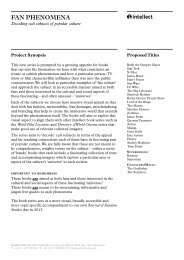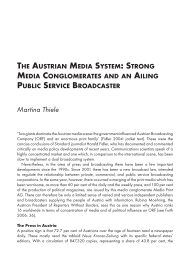Anthem - Intellect
Anthem - Intellect
Anthem - Intellect
You also want an ePaper? Increase the reach of your titles
YUMPU automatically turns print PDFs into web optimized ePapers that Google loves.
<strong>Anthem</strong><br />
it was still presented as a unique and new design, rather than as an adherence to a<br />
pre-existing symbol. However, for the music, none of the proposed new compositions<br />
gave any hope of finding anything remotely as attractive as what the European canon<br />
of classical music had to offer. The implied signifying result was already by such a<br />
decision to devalue later developments in music and to instead inscribe the anthem in<br />
a rather conservative classicist tradition.<br />
This also makes Beethoven’s oeuvre a clearly privileged intertext, in particular his<br />
Ninth Symphony and Schiller’s poem which he integrated in its final movement. I<br />
will therefore save comparative references to other intertexts until next section, in<br />
order to focus on the most obvious contexts for the European anthem, in a concentric<br />
set of circles from the European anthem, over Beethoven’s Ninth’s fourth movement,<br />
Beethoven’s Ninth symphony as a whole, Beethoven’s total oeuvre and Schiller’s poem<br />
to early nineteenth century bourgeois culture and art music and post-revolutionary<br />
modern capitalism in general. As Esteban Buch has argued, the <strong>Anthem</strong> functions as<br />
a metonym for ‘the whole fourth movement, the whole Ninth symphony, the whole<br />
work of Beethoven, or even the whole Western “great music”, which, in this way, is<br />
appealed to in order to reinforce the ethical and political legitimacy of the European<br />
community as a whole’. 356<br />
The interpretive analysis could either start with the EU anthem as a separate work<br />
in its own right or approach it as a reworked excerpt from Beethoven’s symphony.<br />
While only a minor group of art music specialists know the symphony context in any<br />
greater detail, many will associate the anthem to Beethoven and thus have some basic<br />
idea about some of those contextual aspects as well. The EU itself repeatedly makes<br />
it known that the anthem has precisely that origin. The European anthem as such is<br />
not yet sufficiently established to have full autonomous work status, even though this<br />
may possibly change in the future, should the anthem survive and become successful,<br />
in the way that for instance the Eurovision tune for most listeners has managed to<br />
cut off its ties to Charpentier’s Te Deum, as will be discussed below. There are many<br />
different anthem versions of shifting length, sung or instrumental, so that it remains<br />
a bit uncertain how it goes as such, and in settings where it is used, it is repeatedly<br />
linked back to Beethoven, so that the melody’s origin in Beethoven’s symphony still<br />
tends to overshadow its independent existence as EU’s anthem. Therefore, I will here<br />
start my analysis by relating the <strong>Anthem</strong> to its original Beethoven context, rather<br />
than treating it as a completely distinct work. I will first discuss how it has been<br />
understood in its original context within Beethoven’s own work, and then in the<br />
following section listen closer to the arrangements of the Ode melody that have been<br />
presented as the European anthem. Though it may sometimes be difficult to keep<br />
them strictly apart, I will strive to reserve the term ‘<strong>Anthem</strong>’ for the EU version of<br />
the tune, while speaking of the ‘Ode’ when discussing the core melody as found in<br />
the symphony.<br />
159












